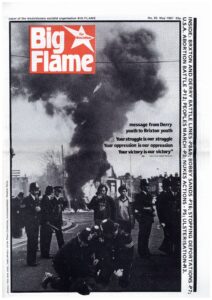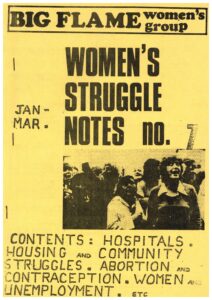
'The 1974 dossier of Class Struggle' a 300 page document produced by former Big Flame member, Ed Emery.
Who were Big Flame?
In this blog post, our Big Flame Project Researcher, Seth Wheeler, explores the roots of the socialist revolutionary organisation, Big Flame.
Emerging on Merseyside out of the upswing in political activity that characterized university life at the end of the 1960s, the libertarian socialist organization Big Flame (active between 1970-1985) are notable in their attempt to synthesize the concerns of the then burgeoning women’s liberation movement, with their commitment to ‘rank-and-file’ workplace and community organization and their rejection of Leninist vanguardism, which put them at odds with much of Britain’s extra-parliamentary opposition during the 1970s.
While never numbering more than 200 members, Big Flame certainly ‘boxed above their weight’ influencing the trajectory, debate and activity of the domestic left and its associated social movements throughout the 1970s. Alongside Ed Emery’s irregular Red Notes journal (1974-present), Big Flame are significant for introducing the analysis and ideas associated with Italy’s Operaisti to Anglophone audiences, notably introducing Operaismo’s ‘class compositional’ frameworks- which continue to inform the analysis and activity of contemporary activists (as in the example of Notes from Below).
Through the pages of their eponymously titled newspaper, militants reported on local community and workplace struggles, national strikes and international solidarity campaigns (significantly in the ‘Troops Out’ Movement in which they took a leading role). Through their internal bulletins they introduced domestic militants to the work of Toni Negri, Mario Tronti and Marie Rosa Della Costa among other notable figures attached to what would later become known as ‘autonomist Marxism’

It is worth noting that during the 1970s Big Flame were the only outward facing and organized expression of a much wider milieu of militants to which they belonged, best understood as ‘the libertarian left’. Many within this loose tendency favored ad-hoc political association (coming together for a specific campaign or event) over the long-term commitments demanded by Big Flame’s ‘party’ organization, yet despite these distinctions Big Flame remained active within this broader subculture, constituted as it was as a network of collective houses, radical community centers, Claimant’s Unions, radical bookshops and squats. Texts belonging to this tendency can be found across various collections held in WCML’s archive, notably in collections associated with the Women’s Movement, anti-fascism, squatting and housing campaigns.
Influenced by events in Paris and further afield during the ‘long ’68’, many in Big Flame also looked closer to home for inspiration, in particular to the writing and activity of the British libertarian socialist organization Solidarity (active 1960-1990) with whom they shared a rejection of Bolshevik vanguardism, and a commitment to rank and file organisation.
WCML also holds significant runs of material associated with Solidarity – including pamphlets, magazines, journals, alongside several rare examples of correspondence, much of which points toward a period of productive and principled discussion between the two organizations.

WCML’s Big Flame archive contains a near full run of their national newspaper, including several regional variations that were produced by their different local branches, discussion bulletins, pamphlets, leaflets, journals, internal correspondence and reports from their various commissions ( their women’s commission, Ireland commission, Industrial commission etc).
The rich intellectual life of the organization is reflected throughout these documents, demonstrating their concerns, interests and commitment to building a non-coercive and inclusive mass politics, the parameters of which continue to chime with the theoretical and organizational concerns of contemporary activist groups- in particular – their discussions regarding social reproduction and the often-unpaid care work traditionally undertaken by women and marginalized groups, which now seem farsighted
Many notable figures have passed through the organization during its short history, including the theorists Lynne Segal and Paul Gilroy- to name but a few. The organization also influenced the lives of other public figures, including the Black British artist Steve McQueen, who was gifted a camera and introduced to photography by a Big Flame member.
The Big Flame archive is available to view at the Working Class Movement Library.